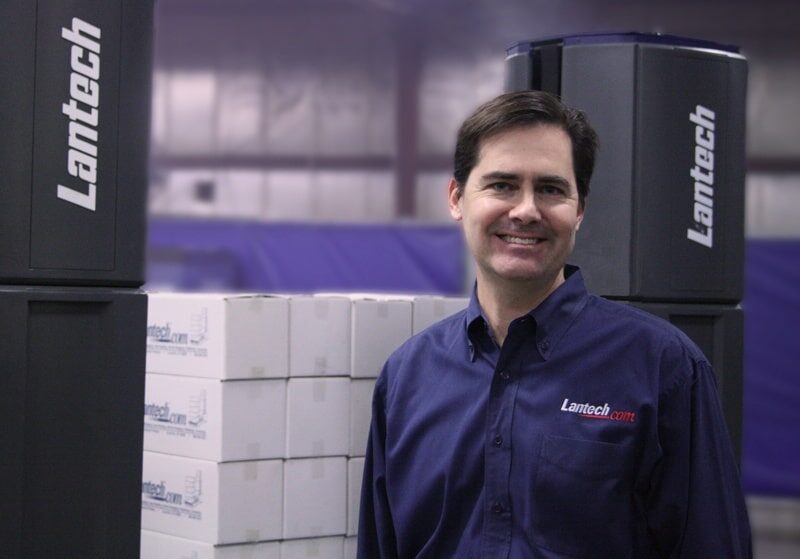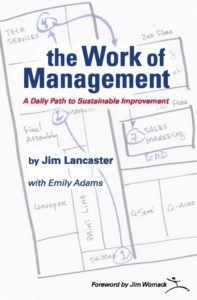Mark's Note: Jason reached out to ask if he could write a review of Jim Lancaster's book, so here we go… thanks to Jason for this thoughtful review. You might also be interested in my podcast interview with Jim about his book.
The story in the book The Work of Management, by Jim Lancaster, is about the re-birth of a Lean journey for Lantech, a company first introduced in the 1996 seminal book, Lean Thinking, by Jim Womack and Daniel Jones.
Like so many organizations, Lantech had experienced fantastic results early in their journey with Lean thinking. They had converted their production process to one piece flow. Manufacturing lead time on some products went from 14 weeks to eight hours. And they witnessed some breakthrough results with Kaizen event after Kaizen event.
Yet, something was missing. Financially, the company was not performing as well as expected. The gains from improvements soon began to slip and processes regressed back to their prior state.

With the guidance of a Lean sensei, Bob Morgan, Lantech CEO Jim Lancaster learned that they were missing the core of Lean. The key to sustainable success was not episodic Kaizen events.
The key was the never-ending daily management and improvement of the work on the floor and “resolving frontline problems immediately.” Jim realized that it was everyone's job (including his), every day, to support the frontline workforce where the real value is created.
It's the gemba, or the daily “grind,” where we see value created, but also where we see the real struggles that impede value creation.
Below are some key highlights some of the critical “a-ha” moments during his personal journey.
Value Creation
Lancaster soon came to the realization that for the company to flourish, it should focus and support the frontline workers daily because they were the ones creating value, not the management team. He makes several insightful statements about value creation and its link to revenue:
“When we favor the needs of the people who are actually creating the value, we are favoring the continued ability of the company to create revenue. The boss is rarely the person creating value. In my experience, customers are willing to pay for real goods and services, not graphs and presentation slides and other tools of management.” (pg. 54)
And:
“The front line creates revenue and, therefore, value. If we focus first on value creation, we make money. And making money is how a business stays open.” (pg. 56)
Probably the most powerful and insightful section of the entire book, and one that challenges conventional management thinking, is where Jim provides the reasoning on why the time of a frontline worker should always be prioritized over the time of the “six-figure boss.”
He writes:
“In every industry, people make the mistake of thinking that we should support the productivity of the boss, making a six figure salary, over the productivity of a $30K-a-year machine operator or welder or transactions clerk. If we save the boss 30 min. worth of work, the thinking goes, we will have created more value than if we saved an operator 30 min. work of work. The kind of thinking is a trap, especially in the case of six-figure bosses who do not create revenue. Let me be clear: managers and executives are useful to the extent they can make direct-value creators more efficient and effective. Yet very little of their time is spent actually doing this. So, bosses are not a resource that we should optimize. In general, bosses bring value to the business only when they improve the work of the people creating value.” (pg. 55)
Standardized Work
A cursory review of the standardized work at Lantech would indicate that they had all the right elements on the shop floor: standard work sheets, visual management, takt time calculations, etc. But, they soon discovered that floor operators' work methods differed from the established standards.
From the book:
“The presumption was that if the operator just had a clear set of steps and a time frame, they would do the work in that manner and sequence. The truth is operators do their work in the way that is easiest, least tedious, and most intuitive…” (pg. 62)
Most of the displayed standard work also became obsolete due to so many production and engineering changes.
Rather than taking the all-too-common management approach of blaming the workers for not following the standards, the team at Lantech rolled up its sleeves and redefined how it developed standardized work that incorporates the “human dimension.” Like a true Lean leader, Jim recognized that their old way of implementing standardized work lacked respect for the frontline workers.
Part of their revelation was that they should remove the tedious steps (including memorization) in standardized work and that the work should be as intuitive as possible to the worker (a.k.a. respect for people).
“When a task is completed, a person's hand should naturally fall upon the tools and materials for the next bit of work. This is intuitive standardized work.” (pg. 63)
Jim makes an analogy to software. Great software, like an app on your smartphone, has a natural, intuitive user interface where users don't require massive amounts of training; it seamlessly guides the user without causing feelings of confusion, ambiguity, or frustration.
To address the issue of endless production and engineering changes, Lantech realized that they simply had to make the standardized work flexible enough to accommodate changes, build in andon-type signals to flag issues, and to respond immediately.
“Sustainable standardized work should also be flexible enough to adapt to whatever variables get thrown into the mix today…and there should be signals to team leaders who make appropriate adjustments / corrections.” (pg. 64)
Through a procurement example, Jim re-iterates the importance of chasing down problems, solving them, and then, most importantly, creating “new or revised standardized work to lock in the solution.” (pg. 70)
In this procurement example, production hit a roadblock when a buyer simply forgot to notate an extra processing step that is standard for all European orders. Again, rather than scolding the buyer and reminding the rest of the team not to make the same mistake, Lantech leadership assembled a cross-functional team to immediately investigate the WHY, not the WHO.
Their solution included the development of standardized work for a buyer (which had never been created) and to embed a user prompt in the electronic scheduling form, and they also added written steps into the training for the new buyers. Lantech had not only created standardized work, but built it in a way so that it was a natural part of the buying process.
Go See / Solving the Immediate Problem
While one piece flow helps to surface defects during the production process, defects can still occur.
Jim and the Lantech team learned to attack problems as soon as they appeared, and the process for resolving issues always begins by going to “see” what was actually happening on the shop floor.
For example, rather than sitting in an office and building and tracking a list of discovered defects and the current resolution process for each one, quality engineers were deployed to the floor to audit built machines and then immediately chase down the source of any discovered defects and begin resolving those defects.
The results were not surprising. For one machine in particular, the average number of defects found during inspection dropped from seven to one.
As usual, Jim simply and eloquently reflects on what he and Lantech learned:
“I learned an indelible truth: solving the problem that presents itself now is more valuable that finding and attacking the most important problems we have. Solving today's problems – the problems that might seem simple or insignificant – has helped us improve productivity and quality like no other initiative in my 21-year tenure.” (pg. 78)
Why This Book is Different
This isn't just book about leadership in regard to an organization's Lean journey. The reader becomes immersed in the CEO's daily thoughts. You experience his fears, his frustrations, his challenges, and many “a-ha” moments as Lantech slowly re-invented itself. The reader also gets the joy of seeing first-hand the humble transformation of a CEO.
Finally, you also see the transformation of some of his management team which is very inspiring. Like Jim, they transformed from “tellers” and “do-ers” to “listeners” and “coaches.” They discovered that it's latter that is the key to improving and sustaining those improvements long term in any organization.
Please scroll down (or click) to post a comment. Connect with me on LinkedIn.
Let’s work together to build a culture of continuous improvement and psychological safety. If you're a leader looking to create lasting change—not just projects—I help organizations:
- Engage people at all levels in sustainable improvement
- Shift from fear of mistakes to learning from them
- Apply Lean thinking in practical, people-centered ways
Interested in coaching or a keynote talk? Let’s start a conversation.





![When Was the Last Time a Leader Around You Admitted They Were Wrong? [Poll]](https://www.leanblog.org/wp-content/uploads/2025/07/Lean-Blog-Post-Cover-Image-2025-07-01T212509.843-238x178.jpg)



![When Was the Last Time a Leader Around You Admitted They Were Wrong? [Poll]](https://www.leanblog.org/wp-content/uploads/2025/07/Lean-Blog-Post-Cover-Image-2025-07-01T212509.843-100x75.jpg)
